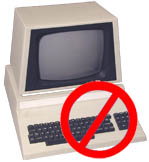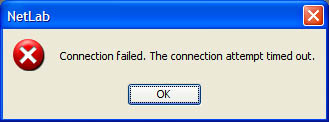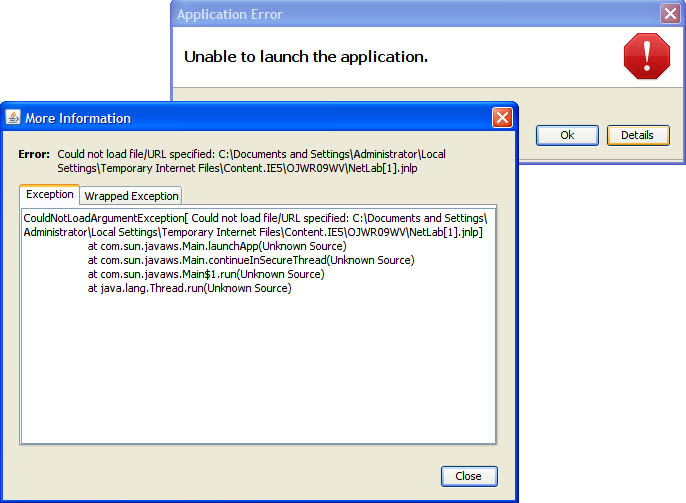·
·
·
·
·
·
·
·
·
·
Frequently Asked Questions
What is Java and why do I need it?
Java is a sophisticated software platform that NetLab is built on. It
provides user interface components, graphics rendering, internet access
functionality and more in a way that is independant of the underlying
operating system. This means that Java must be installed on your computer
in order to run the application.
The download is approximately 12MB. However, it only needs to be
downloaded once, and doing so will allow you to run other Java-based
applications as well. All university computer pools should already have a
suitable version of Java installed.

Back To Top
What operating systems are supported?
NetLab is a pure Java application and so the same application will run on any
operating system that has Java SE 6 or above installed. No seperate downloads
of NetLab for specific operating systems are required. Versions of Java are
available for Windows, Linux, Solaris, Mac OS X and FreeBSD on various CPU
platforms (see Where can I download Java?).
NetLab's user interface will adapt to resemble the look of the underlying
operating system.

Back To Top
What version of Java is required?
NetLab requires at least Java SE 6
or later. All university computers should already have a suitable version
of Java installed.
Many personal computers will likely not
have Java SE 6 installed. If this is the case, you will need to download
at least Java SE 6 in order to run NetLab from home. If you do not wish to
download Java, you can still use NetLab from a university computer pool.
Back To Top
Where can I download Java?
There are several vendors that provide Java implementations for various
platforms. Sun Microsystems' implementation is highly recommended for
Windows, Linux and Solaris operating systems. These are available for free
download at
http://java.sun.com/javase/downloads/index.jsp. As well as choosing the
correct download for your operating system, you should also ensure you have
the correct download for your CPU. Windows, Linux and Solaris versions are
available for 32-bit x86 and AMD64 hardware. There are also Solaris versions
for 32-bit and 64-bit SPARC hardware.
Apple provides a Java SE 6 implementation for the Mac OS X operating system
at http://www.apple.com/java that
is fully compatible with NetLab.
Java SE 6 implementations are also available for FreeBSD on various hardware
platforms at http://www.freebsd.org/java.
However these are still in development and running NetLab in a FreeBSD
environment is not recommended.
Note: You may see these downloads referred to as version 1.6 instead of 6.
These are equivalent; both are acceptable.
Back To Top
Do I Download the JRE or the JDK?
The JRE is the Java Runtime Environment, and it contains everything you need to
run Java applications such as NetLab. The JRE download is around 12MB.
The JDK is the Java Development Kit, and is needed only by software developers
who intend to create Java applications. It includes the JRE, but also includes
the Java compiler other development tools. This download is much larger at
around 50MB. You only need to download the JDK if you intend to create your
own Java applications.
For students who are currently studying or intend to study a Java programming
course, the JDK download is recommended. If you do not intend to develop Java
applications, the JRE download is sufficient.
Back To Top
Which UniSA computers can run NetLab?
Currently, only computers at Mawson Lakes campus have Java SE 6 installed
and are capable of running NetLab. These include:
-
All computers in the GP building and P building computer pools.
-
All computers in the F building computer pools and computer barn.
-
All computers in the Real Time Laboratory of the SCT building.
-
All lecture theatre / AV computers.
Unfortunately, the following computers are currently
not capable of
of running NetLab:
-
All student computers in the Mawson Center.
-
All walk up PCs.
-
All computers in the library.
-
All Unix workstations.
Efforts are underway to ensure that Java SE 6 will be installed on these
machines in the very near future so that NetLab can run on them.
Back To Top
What are the other minimum system requirements?
The only formal requirement is an installation of Java SE 6 or later. However,
NetLab's complex user interface rendering is CPU intensive. Also the large
graphic images of the instrument front panels consume alot of memory. Thus a
system with a CPU of 1GHz or above and 512MB of RAM or more is
strongly recommended.

Back To Top
How do I launch the application?
NetLab uses Java Web Start technology. You can launch the application simply
by clicking the "Launch NetLab" link on the NetLab Access page of this website.
Provided you have Java SE 6 or later installed, the application will download,
install and launch automatically. The installation will place shortcuts on
your desktop and in your system menu (eg. the Start menu on Windows) which
you can use to launch NetLab again in the future. This download will only
need to be done once. You can also launch NetLab again in the future by
clicking the same link on the website, and it should launch immediately as
it does not need to be downloaded again.

Note that Web Start technology supports automatic updates to future versions
of the application. Should you launch the application when a new version
is available, the new version will be downloaded and installed automatically.

Back To Top
Why am I being warned that the application is not trusted?
This is a security feature provided by the Java platform for your own protection.
NetLab requires certain privileges such as accessing the internet and writing
to your hard disc (when saving data). Thus NetLab is signed with a digital
certificate that uniquely identifies it as a product from The School of Electrical
and Information Engineering, University of South Australia. By clicking "Run",
you are declaring that you trust this source, and that the application is allowed
to access these resources.
It is recommended that you select "Always trust content from this publisher" so
that you will not be presented with this dialog again when you run NetLab in the
future, as you have declared that you trust any application signed with our
certificate (i.e. any application produced by us).

Back To Top
Why does my NetLab client fail to connect?
Ensure that you are connected to the internet. If the connection attempt still
fails, you may be behind a firewall. Configure your firewall to allow outgoing
connections to TCP port 8000. Alternatively, you may choose to disable your
firewall completely. If you continue to have connection problems, you can
contact us for further assistance.

Back To Top
Why do I see a warning on Windows Vista with Internet Explorer 7?
The following warning dialog is displayed when launching the application from the
link in the website from within Internet Explorer 7 on Windows Vista. It simply
means that clicking the link will launch an external application, which in this
case is the Java Web Start launcher from Sun Microsystems, which in turn will
download and launch NetLab. If you are presented witht this dialog, you should
click "Allow".

Back To Top
Unable to launch the application?
If you're particularly unlucky, you may be presented with a error dialog
similar to one shown below. This problem only occurs with Internet Explorer
when your download cache (Temporary Internet Files) is full. There are
several possible solutions:
1. |
Instead of left clicking on the "Launch NetLab" link, right click
and select "Save Target As...", and save the JNLP file to a known
location, such as your desktop. You can then launch the application
by double-clicking this file.
Note that this JNLP file is not the entire application, it is a
very small text file (less than 1kB) that is used to by Java WebStart to
download and install the application seperately, so don't be
suprised by the quick download. When you have launched the
application once, you can safely delete the JNLP file
and use the NetLab shortcut in your system menu (eg. Start ->
Programs -> UniSA -> NetLab) to launch the application in the
future.
|
2. |
Clear your cache by deleting your Temporary Internet Files.
To do this, select the Tools menu in Internet Explorer and
select "Internet Options...". In the General tab, under
"Temporary Internet Files", click Delete Files, and click
OK. But be warned, this may take several minutes.
Note: Don't worry, this wont delete anything important.
It merely deletes images and HTML files from web pages that you
have visited in the past that your browser stored when it
displayed the pages.
|
3. |
Use
Mozilla Firefox or
Opera as your browser instead!
|

Back To Top